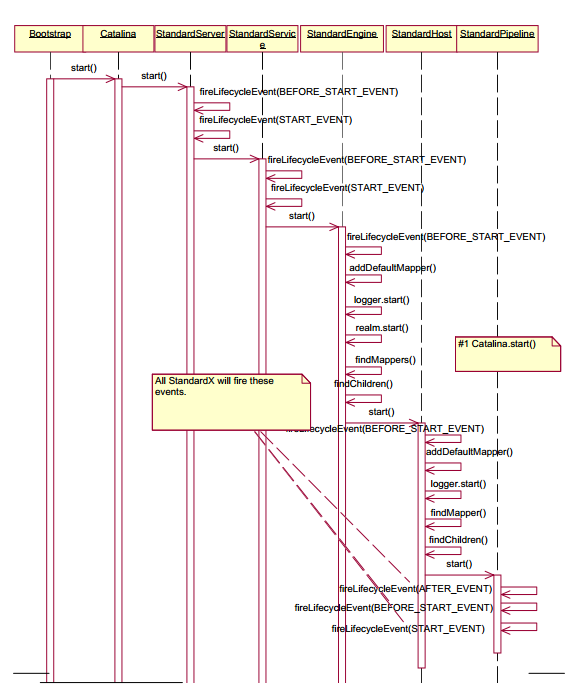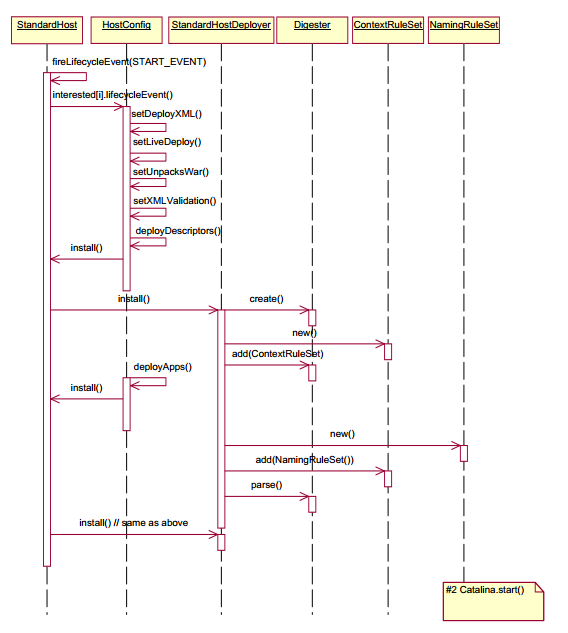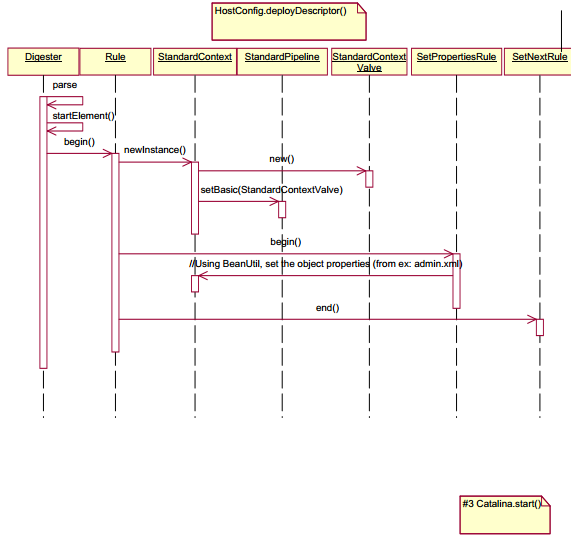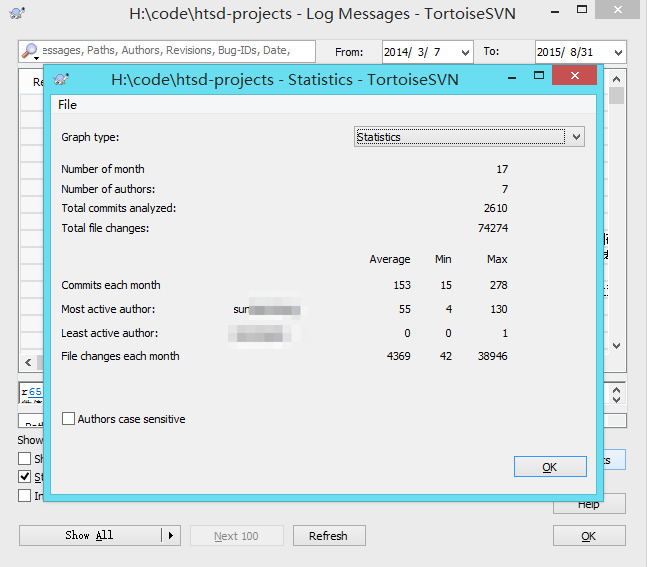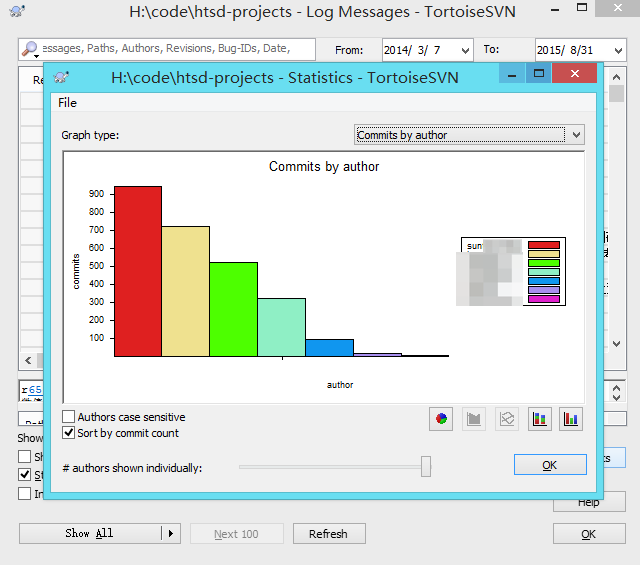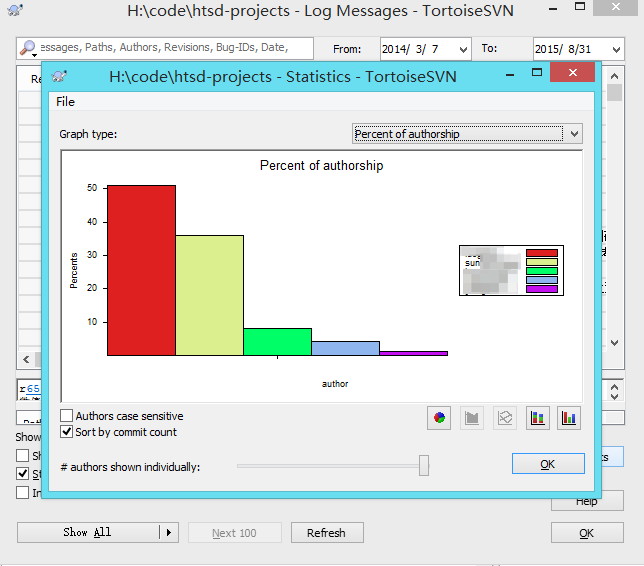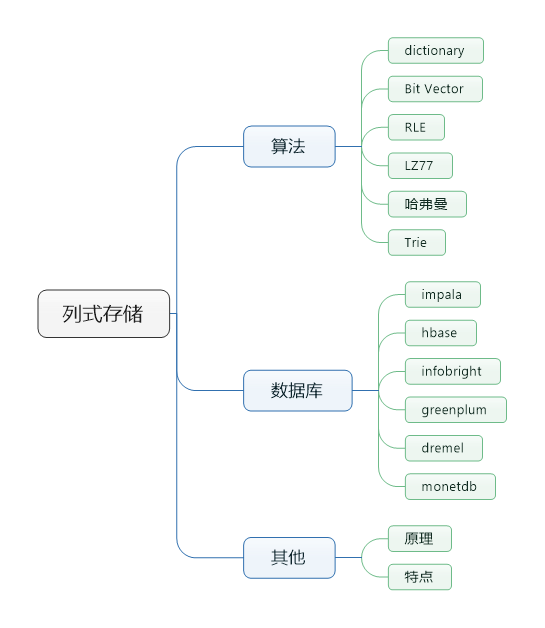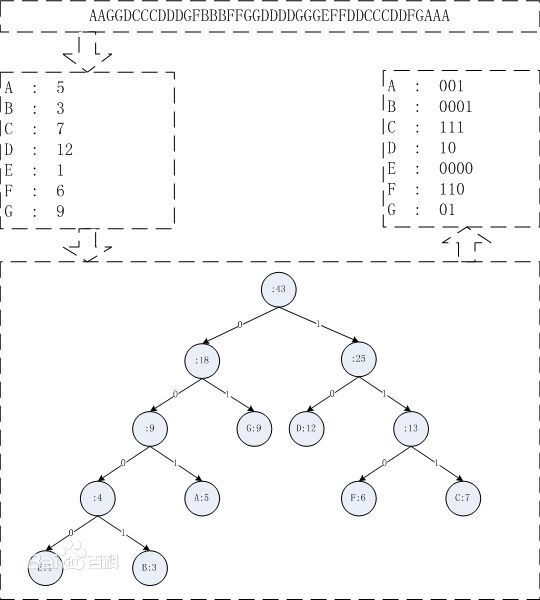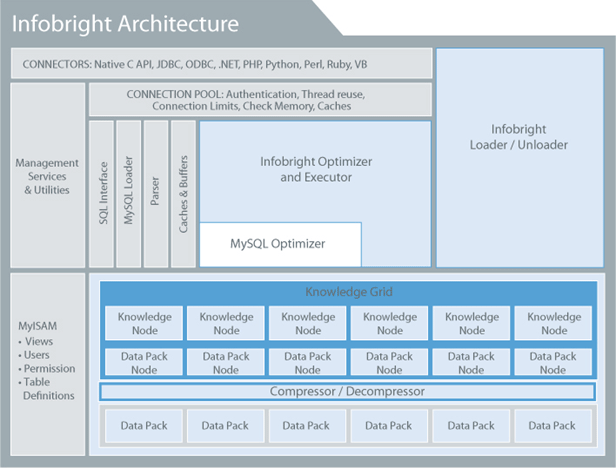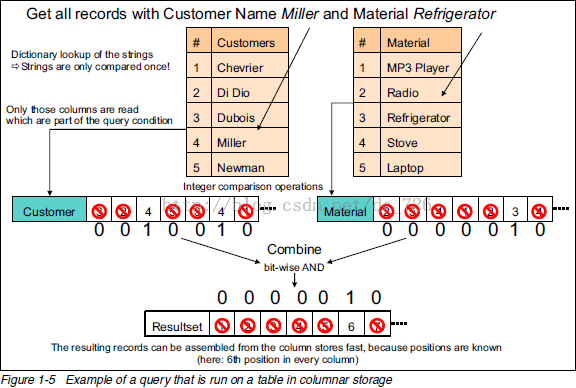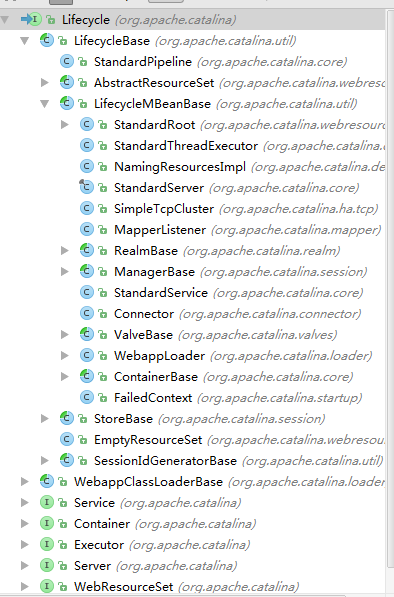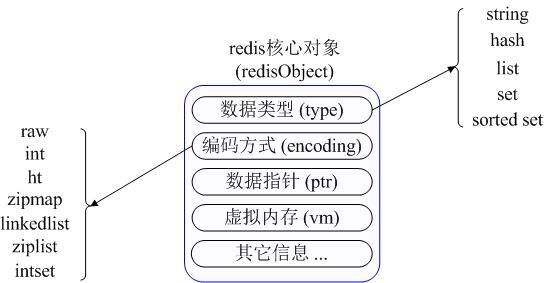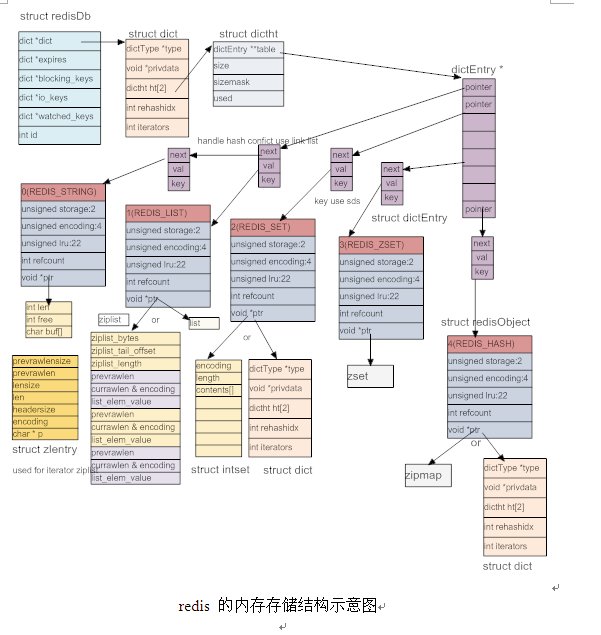一,回顾
上文介绍了Server的启动过程,但是没有详细介绍Container和Connector的详细启动流程,下面我将介绍Container的启动流程。
二,Container的init
下面我看看Container的继承结构:

Engine,Host,Context,Wrapper都属于Container。下面,我们根据server.xml的默认配置结构来看看。
<Engine name="Catalina" defaultHost="localhost">
//LockOutRealm防止暴力破解
<Realm className="org.apache.catalina.realm.LockOutRealm">
<Realm className="org.apache.catalina.realm.UserDatabaseRealm"
resourceName="UserDatabase"/>
</Realm>
<Host name="localhost" appBase="webapps"
unpackWARs="true" autoDeploy="true">
<Valve className="org.apache.catalina.valves.AccessLogValve" directory="logs"
prefix="localhost_access_log" suffix=".txt"
pattern="%h %l %u %t "%r" %s %b" />
</Host>
</Engine>
其中有Realm,这个是TOMCAT的安全域,我们暂时不关心,看其他的几个。
2.1 Engine的initInternal
protected void initInternal() throws LifecycleException {
getRealm();
super.initInternal();
}
方法比较简单,我们关注super.initInternal()方法:
2.2 ContainerBase的initInternal
ContainerBase主要是创建一个startStopExecutor线程池用来启动停止子节点。
ContainerBase
protected void initInternal() throws LifecycleException {
BlockingQueue<Runnable> startStopQueue = new LinkedBlockingQueue<>();
startStopExecutor = new ThreadPoolExecutor(
getStartStopThreadsInternal(),
getStartStopThreadsInternal(), 10, TimeUnit.SECONDS,
startStopQueue,
new StartStopThreadFactory(getName() + "-startStop-"));
startStopExecutor.allowCoreThreadTimeOut(true);
super.initInternal();
}
2.3 StandardHost的initInternal
protected synchronized void startInternal() throws LifecycleException {
String errorValve = getErrorReportValveClass();
super.startInternal();
}
2.4 StandardContext的initInternal
protected void initInternal() throws LifecycleException {
super.initInternal();
if (namingResources != null) {
namingResources.init();
}
if (resources != null) {
resources.start();
}
if (this.getObjectName() != null) {
Notification notification = new Notification("j2ee.object.created",
this.getObjectName(), sequenceNumber.getAndIncrement());
broadcaster.sendNotification(notification);
}
}
2.5 StandardWrapper的initInternal
StandardWrapper的initInternal继承的父类ContainerBase的initInternal。
这样,初始化工作就告一段落了,下面,我们看start方法。
三,Container的start
上文中我们知道,Container的start最终会调用自己的startInternal方法,下面我们看具体实现。
3.1 StandardEngine的startInternal
StandardEngine
protected synchronized void startInternal() throws LifecycleException {
super.startInternal();
}
StandardEngine调用了父类ContainerBase的startInternal方法。
3.2 ContainerBase的startInternal
ContainerBase
protected synchronized void startInternal() throws LifecycleException {
logger = null;
getLogger();
Cluster cluster = getClusterInternal();
if (cluster instanceof Lifecycle) {
((Lifecycle) cluster).start();
}
Realm realm = getRealmInternal();
if (realm instanceof Lifecycle) {
((Lifecycle) realm).start();
}
Container children[] = findChildren();
List<Future<Void>> results = new ArrayList<>();
for (int i = 0; i < children.length; i++) {
results.add(startStopExecutor.submit(new StartChild(children[i])));
}
boolean fail = false;
for (Future<Void> result : results) {
try {
result.get();
} catch (Exception e) {
log.error(sm.getString("containerBase.threadedStartFailed"), e);
fail = true;
}
}
if (fail) {
throw new LifecycleException(
sm.getString("containerBase.threadedStartFailed"));
}
if (pipeline instanceof Lifecycle)
((Lifecycle) pipeline).start();
setState(LifecycleState.STARTING);
threadStart();
}
就这样,ContainerBase会将它的子容器用线程池启动起来。
3.3 StandardHost的startInternal
StandardHost
protected synchronized void startInternal() throws LifecycleException {
String errorValve = getErrorReportValveClass();
super.startInternal();
}
啥也没做,继续调用父类的startInternal方法。
3.4 StandardContext的startInternal
StandardContext
protected synchronized void startInternal() throws LifecycleException {
if (this.getObjectName() != null) {
Notification notification = new Notification("j2ee.state.starting",
this.getObjectName(), sequenceNumber.getAndIncrement());
broadcaster.sendNotification(notification);
}
setConfigured(false);
boolean ok = true;
if (namingResources != null) {
namingResources.start();
}
if (getResources() == null) {
if (log.isDebugEnabled())
log.debug("Configuring default Resources");
try {
setResources(new StandardRoot(this));
} catch (IllegalArgumentException e) {
log.error(sm.getString("standardContext.resourcesInit"), e);
ok = false;
}
}
if (ok) {
resourcesStart();
}
if (getLoader() == null) {
WebappLoader webappLoader = new WebappLoader(getParentClassLoader());
webappLoader.setDelegate(getDelegate());
setLoader(webappLoader);
}
getCharsetMapper();
postWorkDirectory();
boolean dependencyCheck = true;
try {
dependencyCheck = ExtensionValidator.validateApplication
(getResources(), this);
} catch (IOException ioe) {
log.error(sm.getString("standardContext.extensionValidationError"), ioe);
dependencyCheck = false;
}
if (!dependencyCheck) {
ok = false;
}
String useNamingProperty = System.getProperty("catalina.useNaming");
if ((useNamingProperty != null)
&& (useNamingProperty.equals("false"))) {
useNaming = false;
}
if (ok && isUseNaming()) {
if (getNamingContextListener() == null) {
NamingContextListener ncl = new NamingContextListener();
ncl.setName(getNamingContextName());
ncl.setExceptionOnFailedWrite(getJndiExceptionOnFailedWrite());
addLifecycleListener(ncl);
setNamingContextListener(ncl);
}
}
if (log.isDebugEnabled())
log.debug("Processing standard container startup");
ClassLoader oldCCL = bindThread();
try {
if (ok) {
Loader loader = getLoader();
if (loader instanceof Lifecycle) {
((Lifecycle) loader).start();
}
setClassLoaderProperty("clearReferencesStatic",
getClearReferencesStatic());
setClassLoaderProperty("clearReferencesStopThreads",
getClearReferencesStopThreads());
setClassLoaderProperty("clearReferencesStopTimerThreads",
getClearReferencesStopTimerThreads());
setClassLoaderProperty("clearReferencesHttpClientKeepAliveThread",
getClearReferencesHttpClientKeepAliveThread());
unbindThread(oldCCL);
oldCCL = bindThread();
logger = null;
getLogger();
Cluster cluster = getClusterInternal();
if (cluster instanceof Lifecycle) {
((Lifecycle) cluster).start();
}
Realm realm = getRealmInternal();
if (realm instanceof Lifecycle) {
((Lifecycle) realm).start();
}
fireLifecycleEvent(Lifecycle.CONFIGURE_START_EVENT, null);
for (Container child : findChildren()) {
if (!child.getState().isAvailable()) {
child.start();
}
}
if (pipeline instanceof Lifecycle) {
((Lifecycle) pipeline).start();
}
Manager contextManager = null;
Manager manager = getManager();
if (manager == null) {
if (log.isDebugEnabled()) {
log.debug(sm.getString("standardContext.cluster.noManager",
Boolean.valueOf((getCluster() != null)),
Boolean.valueOf(distributable)));
}
if ( (getCluster() != null) && distributable) {
try {
contextManager = getCluster().createManager(getName());
} catch (Exception ex) {
log.error("standardContext.clusterFail", ex);
ok = false;
}
} else {
contextManager = new StandardManager();
}
}
if (contextManager != null) {
if (log.isDebugEnabled()) {
log.debug(sm.getString("standardContext.manager",
contextManager.getClass().getName()));
}
setManager(contextManager);
}
if (manager!=null && (getCluster() != null) && distributable) {
getCluster().registerManager(manager);
}
}
if (!getConfigured()) {
log.error(sm.getString("standardContext.configurationFail"));
ok = false;
}
if (ok)
getServletContext().setAttribute
(Globals.RESOURCES_ATTR, getResources());
if (ok ) {
if (getInstanceManager() == null) {
javax.naming.Context context = null;
if (isUseNaming() && getNamingContextListener() != null) {
context = getNamingContextListener().getEnvContext();
}
Map<String, Map<String, String>> injectionMap = buildInjectionMap(
getIgnoreAnnotations() ? new NamingResourcesImpl(): getNamingResources());
setInstanceManager(new DefaultInstanceManager(context,
injectionMap, this, this.getClass().getClassLoader()));
getServletContext().setAttribute(
InstanceManager.class.getName(), getInstanceManager());
}
}
if (ok) {
getServletContext().setAttribute(
JarScanner.class.getName(), getJarScanner());
}
mergeParameters();
for (Map.Entry<ServletContainerInitializer, Set<Class<?>>> entry :
initializers.entrySet()) {
try {
entry.getKey().onStartup(entry.getValue(),
getServletContext());
} catch (ServletException e) {
log.error(sm.getString("standardContext.sciFail"), e);
ok = false;
break;
}
}
if (ok) {
if (!listenerStart()) {
log.error(sm.getString("standardContext.listenerFail"));
ok = false;
}
}
if (ok) {
checkConstraintsForUncoveredMethods(findConstraints());
}
try {
Manager manager = getManager();
if (manager instanceof Lifecycle) {
((Lifecycle) manager).start();
}
} catch(Exception e) {
log.error(sm.getString("standardContext.managerFail"), e);
ok = false;
}
if (ok) {
if (!filterStart()) {
log.error(sm.getString("standardContext.filterFail"));
ok = false;
}
}
if (ok) {
if (!loadOnStartup(findChildren())){
log.error(sm.getString("standardContext.servletFail"));
ok = false;
}
}
super.threadStart();
} finally {
unbindThread(oldCCL);
}
if (ok) {
if (log.isDebugEnabled())
log.debug("Starting completed");
} else {
log.error(sm.getString("standardContext.startFailed", getName()));
}
startTime=System.currentTimeMillis();
if (ok && (this.getObjectName() != null)) {
Notification notification =
new Notification("j2ee.state.running", this.getObjectName(),
sequenceNumber.getAndIncrement());
broadcaster.sendNotification(notification);
}
getResources().gc();
if (!ok) {
setState(LifecycleState.FAILED);
} else {
setState(LifecycleState.STARTING);
}
}
上面代码有点长,主要是做了资源的设置,类加载器的设置,session管理的设置等。当然也启动了pipeline。但是有一点我们需要注意的是,子容器并不是在pipeline的StandardContextValve中传递执行的。那么是在哪里呢?其实就在StandardContext中的startInternal执行的。为什么要这样设计呢?我们发现,这是由于servlet在xml中的顺序决定了启动顺序。
接下来有人会不会有另一个疑惑,要是我在server.xml没有配置context,只是放在了webapps目录下面,那么这个context是如何加载的呢?接下来,我就讲讲这个。
四,Context调用时机
context可以有2种表现形式,一种是直接写在server.xml文件中,另一种是放在tomcat的webapps目录下。
第一种形式已经在前面介绍过了,下面,我们介绍第二中形式。
4.1 Host启动触发监听事件
大家还记得否,当我们每次调用LifecycleBase的start方法时,都会调用下面这句:
setStateInternal(LifecycleState.STARTED, null, false);
那这句话做了什么工作呢?我们看其源码实现:
LifecycleBase
private synchronized void setStateInternal(LifecycleState state,
Object data, boolean check) throws LifecycleException {
...//检查状态
this.state = state;
String lifecycleEvent = state.getLifecycleEvent();
if (lifecycleEvent != null) {
fireLifecycleEvent(lifecycleEvent, data);
}
}
protected void fireLifecycleEvent(String type, Object data) {
LifecycleEvent event = new LifecycleEvent(this, type, data);
LifecycleListener interested[] = listeners;
for (int i = 0; i < interested.length; i++) {
interested[i].lifecycleEvent(event);
}
}
我们看到,这里会触犯监听器执行感兴趣的事件。那在StandardHost中有哪些监听器呢?
4.2 创建Host监听
我们要跳到Digester那一块了,大家还记得Digester那块嘛?在Catalina的createStartDigester() 方法中,我们看到下面一句话:
digester.addRuleSet(new HostRuleSet(“Server/Service/Engine/“));
那这句话内部干了什么呢?我们看其实现:
Digester
public void addRuleSet(RuleSet ruleSet) {
String oldNamespaceURI = getRuleNamespaceURI();
String newNamespaceURI = ruleSet.getNamespaceURI();
setRuleNamespaceURI(newNamespaceURI);
ruleSet.addRuleInstances(this);
setRuleNamespaceURI(oldNamespaceURI);
}
HostRuleSet
public void addRuleInstances(Digester digester) {
digester.addObjectCreate(prefix + "Host",
"org.apache.catalina.core.StandardHost",
"className");
digester.addSetProperties(prefix + "Host");
digester.addRule(prefix + "Host",
new CopyParentClassLoaderRule());
digester.addRule(prefix + "Host",
new LifecycleListenerRule
("org.apache.catalina.startup.HostConfig",
"hostConfigClass"));
digester.addSetNext(prefix + "Host",
"addChild",
"org.apache.catalina.Container");
digester.addCallMethod(prefix + "Host/Alias",
"addAlias", 0);
digester.addObjectCreate(prefix + "Host/Cluster",
null,
"className");
digester.addSetProperties(prefix + "Host/Cluster");
digester.addSetNext(prefix + "Host/Cluster",
"setCluster",
"org.apache.catalina.Cluster");
digester.addObjectCreate(prefix + "Host/Listener",
null,
"className");
digester.addSetProperties(prefix + "Host/Listener");
digester.addSetNext(prefix + "Host/Listener",
"addLifecycleListener",
"org.apache.catalina.LifecycleListener");
digester.addRuleSet(new RealmRuleSet(prefix + "Host/"));
digester.addObjectCreate(prefix + "Host/Valve",
null,
"className");
digester.addSetProperties(prefix + "Host/Valve");
digester.addSetNext(prefix + "Host/Valve",
"addValve",
"org.apache.catalina.Valve");
}
好,在这里我们看到了HostConfig被添加到监听器里面了。那这个HostConfig干了什么呢?我们接下来继续看。
4.3 触发HostConfig调用start方法
我们看他的lifecycleEvent方法实现:
HostConfig
public void lifecycleEvent(LifecycleEvent event) {
try {
host = (Host) event.getLifecycle();
if (host instanceof StandardHost) {
setCopyXML(((StandardHost) host).isCopyXML());
setDeployXML(((StandardHost) host).isDeployXML());
setUnpackWARs(((StandardHost) host).isUnpackWARs());
setContextClass(((StandardHost) host).getContextClass());
}
} catch (ClassCastException e) {
log.error(sm.getString("hostConfig.cce", event.getLifecycle()), e);
return;
}
if (event.getType().equals(Lifecycle.PERIODIC_EVENT)) {
check();
} else if (event.getType().equals(Lifecycle.START_EVENT)) {
start();
} else if (event.getType().equals(Lifecycle.STOP_EVENT)) {
stop();
}
}
我们看到,当传递了一个Lifecycle.START_EVENT事件时,调用了HostConfig的start方法,接下来,我们继续看start方法:
HostConfig
public void start() {
if (log.isDebugEnabled())
log.debug(sm.getString("hostConfig.start"));
try {
ObjectName hostON = host.getObjectName();
oname = new ObjectName
(hostON.getDomain() + ":type=Deployer,host=" + host.getName());
Registry.getRegistry(null, null).registerComponent
(this, oname, this.getClass().getName());
} catch (Exception e) {
log.error(sm.getString("hostConfig.jmx.register", oname), e);
}
if (host.getCreateDirs()) {
File[] dirs = new File[] {host.getAppBaseFile(),host.getConfigBaseFile()};
for (int i=0; i<dirs.length; i++) {
if (!dirs[i].mkdirs() && !dirs[i].isDirectory()) {
log.error(sm.getString("hostConfig.createDirs",dirs[i]));
}
}
}
if (!host.getAppBaseFile().isDirectory()) {
log.error(sm.getString("hostConfig.appBase", host.getName(),
host.getAppBaseFile().getPath()));
host.setDeployOnStartup(false);
host.setAutoDeploy(false);
}
if (host.getDeployOnStartup())
deployApps();
}
start方法首先注册自己的mbean中,然后创建了一个目录,最后部署应用。
4.3 部署应用程序
HostConfig的start方法做了很多事,前面的我们都不关心,我们只看deployApps方法:
HostConfig
protected void deployApps() {
File appBase = host.getAppBaseFile();
File configBase = host.getConfigBaseFile();
String[] filteredAppPaths = filterAppPaths(appBase.list());
deployDescriptors(configBase, configBase.list());
deployWARs(appBase, filteredAppPaths);
deployDirectories(appBase, filteredAppPaths);
}
前面的跟具体功能相关,就不解析了,我们只看最后一段deployDirectories:
protected void deployDirectories(File appBase, String[] files) {
if (files == null)
return;
ExecutorService es = host.getStartStopExecutor();
List<Future<?>> results = new ArrayList<>();
for (int i = 0; i < files.length; i++) {
if (files[i].equalsIgnoreCase("META-INF"))
continue;
if (files[i].equalsIgnoreCase("WEB-INF"))
continue;
File dir = new File(appBase, files[i]);
if (dir.isDirectory()) {
ContextName cn = new ContextName(files[i], false);
if (isServiced(cn.getName()) || deploymentExists(cn.getName()))
continue;
results.add(es.submit(new DeployDirectory(this, cn, dir)));
}
}
for (Future<?> result : results) {
try {
result.get();
} catch (Exception e) {
log.error(sm.getString(
"hostConfig.deployDir.threaded.error"), e);
}
}
}
我们看到,这里获取到了webapps目录下的所有目录,然后使用线程池进行加载每个子目录。
4.4 DeployDirectory内部实现
由于使用的是线程池,我们看它的run方法:
DeployDirectory
public void run() {
config.deployDirectory(cn, dir);
}
返回来调用了HostConfig的deployDirectory方法,我们继续跟踪:
HostConfig
protected void deployDirectory(ContextName cn, File dir) {
Context context = null;
File xml = new File(dir, Constants.ApplicationContextXml);
File xmlCopy =
new File(host.getConfigBaseFile(), cn.getBaseName() + ".xml");
DeployedApplication deployedApp;
boolean copyThisXml = copyXML;
try {
if (deployXML && xml.exists()) {
synchronized (digesterLock) {
try {
context = (Context) digester.parse(xml);
} catch (Exception e) {
context = new FailedContext();
} finally {
if (context == null) {
context = new FailedContext();
}
digester.reset();
}
}
...
}
....
Class<?> clazz = Class.forName(host.getConfigClass());
LifecycleListener listener =
(LifecycleListener) clazz.newInstance();
context.addLifecycleListener(listener);
context.setName(cn.getName());
context.setPath(cn.getPath());
context.setWebappVersion(cn.getVersion());
context.setDocBase(cn.getBaseName());
host.addChild(context);
} catch (Throwable t) {
ExceptionUtils.handleThrowable(t);
log.error(sm.getString("hostConfig.deployDir.error",
dir.getAbsolutePath()), t);
} finally {
...
}
在这里,我们发现,创建了一个Context,并将其添加到Host中,就完成了未在server.xml中配置Context也可以启动webapps目录下的工程了。好的,container启动部分就到此结束了,下文将介绍connector启动部分。
五,流程图
